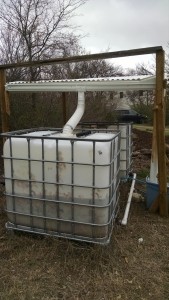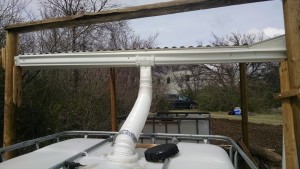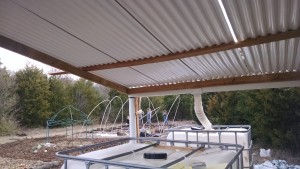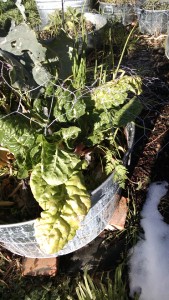One of the challenges of small community gardens can be the cost of bringing water to the property. If the garden is on a vacant lot, then there is no large building from which to gather rainwater. What to do?
But there is a solution, and one garden in Dallas, the Divinekinship Community Garden, is serving as the model.
They have constructed a roof on poles – I call it a rainwater capture shelter. More specifically, it is a roofed, open sided structure approximately 8-9 ft. square, supported with 8’ landscape timbers at the corners (buried about 18” into the ground for stability), with a plastic/fiberglass corrugated roof. The roof is approximately 6 ½ feet high at one end of the structure, and approximately 6 feet high at the other end, so there is a slight slope down to a gutter, which feeds via a flex-spout into an IBC tote. The IBC tote is connected to a second IBC tote for overflow.
An estimate of the rainfall harvesting capacity is: 9’ x 9’ = 81 sq. ft. of roof. x .6 gallons/sq ft/inch of rain = 486 gallons captured in 1” rainfall.
The total cost, exclusive of IBC totes, is approximately $100-$110, if materials are new.
Here are some pictures of the setup. If materials can be scrounged someplace, the cost goes down.
The drought conditions in the Dallas/Fort Worth area continue. And some communities may be facing more severe water restrictions this summer. A check with the National Weather Service revealed that we received 21.32 inches of rain in 2014. In 2013, the annual rainfall was 29.4 inches; in 2012, it was 31.26 inches. Even if there is another water source for the garden, capturing rainfall has the potential to cut the water bill substantially.
And there’s another way to reduce water usage: Mulch. Heavy use of mulch as well as working lots of organic matter into the beds will help reduce the water needs of the growing beds.
My chard came through the recent freezes and snow with flying colors. Almost as if it energized the plant. Love chard.




